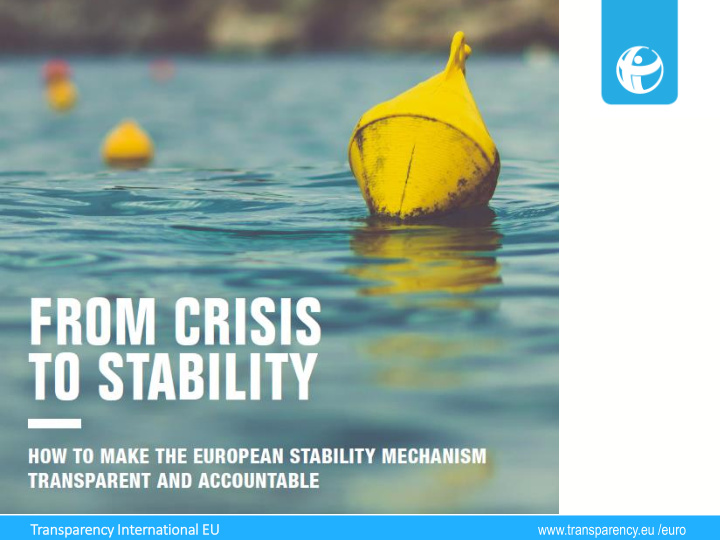



www.transparency.eu /euro Tran ansparency International EU EU
Transparency Intl ‘ initiative and report welcomed MD Declarations of interest (voluntarily) published Further tweaks to gift register www.transparency.eu /euro
BEYOND THE EU TREATIES Unlimited possibilities ‘Bridging’ the no -bailout clause: − Ad hoc GLC − Temporary EFSF − Permanent ESM ‘Eurobonds’ for very low rates Very long maturities (until 2060) act like a debt restructuring With the necessary political will, everything becomes possible www.transparency.eu /euro
EU ‘INTEGRITY ACQUIS’ Embedding the ESM into the EU treaty framework Will enable the ESM to make (enhanced)use of… − − European Court of Auditors EU Data Protection Supervisor − − European Ombudsman Court of Justice of the EU, etc. Enable accountability to Eurogroup and EP EU ‘transparency and integrity acquis’ − Access to documents regulation No. 1049/2001 − EU Staff Regulation − EU Charter of Fundamental Rights, social pillar etc. The ESM should be brought into the EU treaties asap, and in any event before granting it new tasks (EU Monetary Fund) www.transparency.eu /euro
INDEPENDENCE A shareholder-controlled body Consensus-based approach ensures Member States cannot steer ESM policy on their own An emergency procedure is in place to avoid institutional blockage – except by DE, FR, IT No Independent Evaluation Office, but an outside evaluator (Ms Gertrude Tumpel-Gugerell) Unhelpful institutional overlap between Eurogroup and ESM Board of Governors Evaluators ‘ independence should be safeguared institutionally www.transparency.eu /euro
TRANSPARENCY Opening up to a skeptical public No meeting minutes of governance bodies No access to documents procedure − Indirect disclosure via Council of the EU − Economic models and assumptions not public − Social impact assessments (COM since 2015) 2016 Transparency Initiative initiated by Eurogroup recognises legitimacy as an issue; ESM BoG to publish: − Annotated agendas − General ‘summing - up’ letters − Programme-related documents to be published “ more systematically ” on ESM website Degree of institutionalisation: No formal description of the initiative Initiative should be formalised and expanded to include at least BoD www.transparency.eu /euro
ACCOUNTABILITY … is very difficult to organise Strong but decentralised accountability to national governments Uneven accountability to national parliaments No accountability to the Commission (agent) No accountability to the European Parliament (EP) Decentralised accountability for decisions taken at European level cannot work – but direct accountability to parliaments required for national budget contributions Ideas: further develop emergency procedure / pre-approve national budget allocation www.transparency.eu /euro
INTEGRITY Strong integrity standards, in line with international best practice for financial institutions Strong internal governance of integrity issues Adequate whistleblower policy, although its visibility for external observers is weak Declarations of interests remain an issue: BoD, BoG www.transparency.eu /euro
ACCOUNTING VS ACCOUNTABILITY Best practices for financial institutions diligently followed But is the ESM just a pot of money? Political responsibility matters Unclear division of responsibilities between: − Commission (pen-holder) − ESM (legally responsible, cf. Pringle) − Eurogroup / Member States (ultimately in control) Top-notch financial controls, insufficient political control www.transparency.eu /euro
WHO IS ANSWERABLE? A lengthy accountability chain National adjustment programme implementation The CJEU made it Troika and ESM surveillance clear that the duties of the ESM staff, ESM management Commission and Board of Directors/Governors/Eurgroup the ECB, Finance Minister “important as Prime Minister they are, do not entail any power Members of Parliament to make decisions Citizens of their own”. ESM and Eurogroup transparency can help locate responsibility for decisions made www.transparency.eu /euro
INTERGOVERNMENTAL ESM So who is in control? Consensus-based approach De-facto veto for each Member Emergency procedure: 85% of shareholders Germany, France, Italy can block ESM disbursements even if the ECB and Commission jointly deem action to be “essential” for the survival of the euro German Constitutional Court cemented Germany’s veto, Bundestag vote required Untangle institutional overlap, ensure ESM decisions are taken in the ESM Publish meeting minutes or ensure meaningful accountability at European level www.transparency.eu /euro
EXAMPLE: BAILOUT CONDITIONS Eternal wrangling on programme reviews Internal devaluation is unpopular National difficulties in implementing programmes Pro-cyclical austerity unwise, in part based on over-optimistic assumptions − IMF: “ mea culpa”, critical reflection on multipliers − ESM programme: 3.5% primary surplus for 5+ years Low credibility Be transparent on debt sustainability models and assumptions Establish an independent, internal evaluation office www.transparency.eu /euro
Q & A ESM transparency and democratic accountability Ca Carl Do Dola lan, Director cdolan@transparency.org Leo Leo Ho Hoffmann-Axthelm, Research & Advocacy Coordinator leo.hoffmann-axthelm@transparency.org + 32 2893 2463 www.transparency.eu /euro
Recommend
More recommend